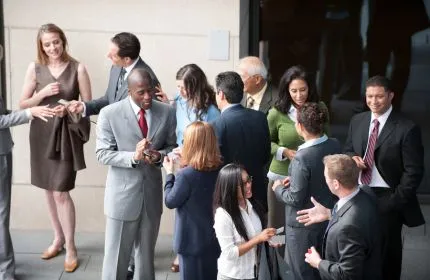10 Tips to Network and Build Relationships Effectively
It can be daunting walking into a room full of strangers, which is why so many of us either avoid networking functions or go to them with a colleague or friend.
The problem is that if you go with someone you already know, the tendency is to stick together and not meet anyone new, which pretty much defeats the whole purpose of networking.
When I immigrated from South Africa to Australia in 2019, I literally did not know anyone, so going to networking functions alone was the only option if I wanted to start building a new network.
Over the years I’ve learnt a number of strategies that have helped me hone my networking and relationship building skills.
1. Prepare beforehand
Look up the speakers and organisers of the event. You may have an opportunity to meet them, and it works in your favour if you know their names or a bit about what they do to start the conversation.
If you happen to be the organiser of an event and have access to the guest list, go through it to see if there’s anyone you know, or that you want to meet. Make a note of it so you can look out for them on the day.
2. Read the room
When I walk into the room, I take a few moments to look around and observe what is happening. I may wander around and listen to the conversations as I walk past.
This gives you an opportunity to read the room, to see who is there and what kind of topics are being discussed.
3. Look for the lonely
I know how difficult it can be for a person to approach someone they don’t know, so I make a point of looking out for people that are on their own or seem a bit lost or awkward. They are typically much easier to approach and are usually really grateful to not have to make the first move.
Even if I am already chatting to someone or in a group, I look out for people out of the corner of my eye, and sometimes invite them to join us or the group.
If I know other people in the room, I will introduce the person to them and help them to start a conversation. If I’ve picked up a commonality between two people, I would mention it. Once two people have found something in common, it’s much easier to have a conversation.
4. Remember names
One of the most important tips of all is to practice remembering people’s names. I know how impressed I am when I meet someone a second time and they call me by name (even more so when they call me Nicola instead of Nicole).
If you don’t hear a name properly or are unsure how to pronounce it, ask the person to repeat it. When you say it back to someone it confirms that you have said it correctly and also helps you towards remembering it.
There are times I’ve asked someone to write their name down for me if I’m having trouble hearing them or saying it.
The more times you can repeat something, the more you commit it to memory. Use people’s names as often as is appropriate throughout the event.
5. Ask questions
If you’re not sure how to start a conversation, start by introducing yourself and then ask a few questions. Most people like to talk about themselves so it’s usually not hard to get things going.
You can make a list of potential questions and memorise a few to kick things off. You don’t need too many as further questions should come to mind as you are listening to what the other person is saying.
Examples:
- How did you hear about this event?
- Do you know the speaker?
- Have you come to this event before (if it’s an ongoing regular event)?
- What business are you in?
- What did you think of the topic today?
6. Listen intently and attentively
Giving someone your full attention makes them feel valued and will help you to learn more about them. The more you learn, the quicker you can build a relationship with someone.
As you listen you can ask further questions to clarify what they are saying. This shows the other person that you are really listening and taking an interest in what they are saying.
Practice remembering what someone is telling you so that you can capture it later. You can then refer back to the information before engaging with that person in the future.
Related blog post: The Forgotten Art Of Listening
7. Make notes of things you learn
I use my phone to make quick notes either between meeting people or straight after the event so it’s fresh in my mind. I store my notes in my Outlook address book but if you have a CRM system, that would be even better.
Some examples of information I take note of are the type of work someone does, their interests, spouse’s name, if they have children and how many, special events coming up, something distinct about what they were wearing, etc.
It may seem like you need to ask someone specific questions to get this kind of information, but you’ll be amazed at what comes up in a natural conversation if you’re taking note, and also if you’re asking questions to encourage deeper connection.
It’s also important to note the date and the event where you met someone. When you’re going to multiple events it’s easy to lose track. When you speak to someone the next time, it’s good to lead with, “We met at [event] in [month]…” so they can work out how they know you if they don’t remember immediately.
8. Invite to connect
The end goal is to get the other person’s contact details. I usually close off with something like, “I’d love to stay in touch if that’s ok with you”, “Do you have a business card?”, or “Are you on LinkedIn”?
I don’t think anyone has ever refused to share contact details with me, as that’s the reason that they are also at the event so it’s an expected outcome.
Although I do hand out my business cards, I prefer to get the other person’s business card. I’m sure there’s many a person with a huge pile of business cards they’ve collected from events and have never looked at again after taking them.
I will also have LinkedIn open on my phone in case someone uses LinkedIn. I search for and find the person while they are in front of me and send a connection request on the spot. I like LinkedIn because you also have a photo of the person which you would usually not have with a business card.
If someone does not have a business card and is not on LinkedIn, I will save their number on my phone and text them straight after the event, so they have my number.
9. Follow up and check in
Networking is only valuable if you continue the relationship beyond the event where you met someone. I typically follow up with a text, email, or LinkedIn message straight after the event or on the same day.
I’ll start with something like “It was great to have met you at [event name] today”, and then mention something that shows I was listening to them. For example, if they had mentioned they were going on a trip, it could be, “Have a safe trip to Sydney next week”.
Although it’s not possible to keep checking in on every single person you meet, make a point of checking in at regular intervals with the contacts you want to continue building a relationship with. This may just be a hello, a birthday greeting, or a coffee catch-up.
10. Use multiple channels
Every person has a different preference when it comes to communication channels. Some people prefer a phone call, others email or a text. Use multiple channels to stay in touch with people so you can cover all the preferences.
You will probably start to notice which channels to use for which people – something else you can take note of to communicate more effectively with them.
There you have it, my tips and strategies for networking and building relationships.
I challenge you to register for a networking event right now, to attend it on your own, and to leave having met three new people.
Will you accept this mission?
This blog post will not self-destruct, so please bookmark, and share far and wide 😊



